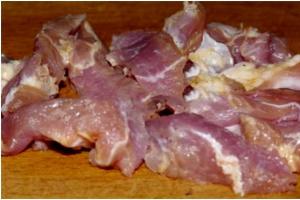To get rid of dampness, you need to carry out a number of preparatory measures. Understand why it appeared, where the moisture is coming from and how you can fix it. You will learn about all this from our article.
Dampness is a very unpleasant phenomenon that can destroy stored crops. If moisture “settles” in the room, this can lead to destruction of the structure and deterioration in the health of everyone who regularly goes down to the cellar or basement. Read about why dampness “comes to visit” and how to get rid of it as quickly as possible in our material.
Dampness in the house - causes
Condensation forms on ceilings, floors and walls for a number of reasons. The most common causes of dampness are the following factors:
ventilation problems. Errors at the design or construction stage lead to poor ventilation in the room. The most common mistake is the following: poorly laid floor slabs and construction debris block ventilation ducts;
When there is a difference in temperature inside and outside the room, condensation forms on the windows and walls, and this is the first sign that mold will soon appear.
level up groundwater . In spring and autumn, when basements and cellars begin to flood due to heavy rains, dampness also increases. Poor drainage leads to water accumulating in underground storage facilities, the humidity level rises sharply, and the room turns into an eternally damp closed system;
capillary penetration of moisture from the soil or through cracks. If the foundation was built in violation of technology, then after some time due to temperature changes on it interior walls droplets of moisture will appear. Over time, this can lead to partial damage to the walls and even their collapse.
Mold spores can be caused by many dangerous diseases, including cancerous tumors
Why is dampness dangerous?
The appearance of condensation and characteristic bad smell These are just the first signs of impending trouble. Condensation causes the following consequences:
mold and mildew appear; temperature regime and the level of humidity in the room; microorganisms harmful to humans multiply; walls, ceilings and ceilings are constantly waterlogged.
Because of this, the finishing suffers; the destruction of the foundation, walls and ceilings begins.
Concrete surfaces and tiles are most often attacked by mold fungi
How to get rid of dampness
First of all, all summer residents are concerned with the question of how to remove dampness. There are several reliable ways to eliminate dampness in the cellar and basement, but first you need to find out what caused the appearance excess moisture. To do this, carefully inspect the room:
- If droplets of water appeared on the walls and ceiling, the reason is a violation of ventilation;
- puddles on the floor indicate an increase in groundwater levels;
- droplets only on the walls hint at the lack of basement waterproofing.
Now let's look in more detail at ways to eliminate each of the reasons.
How to improve ventilation
If air exchange in a room is poor, the easiest way to improve it is by organizing additional ventilation. There are two types of basement ventilation:
natural - involves the use of the so-called. "vents" - openings around the perimeter of the building. Their total area should be about 1/400 of the total area of the building; forced - implies the use of special equipment that forcibly pumps in fresh air. Typically used in large rooms.
Installation forced ventilation- expensive pleasure
To get rid of condensation on the ceiling and walls, you can carry out the following procedures:
- Thermal insulation utility networks
. If you have communications laid in the basement - water and sewer pipes– then the water temperature in them is always higher than the room temperature. As a result, condensation forms on them. To get rid of heat loss, you need to use a protective shell made of mineral wool, polystyrene foam and extruded polystyrene foam. Hood organization. For additional ventilation of the room, ventilation ducts or pipes are installed. They are usually attached to vertical load-bearing elements or attached to existing structures. Two pipes are installed in the room - exhaust and supply, placing them at different heights from the floor in opposite corners of the room. This is necessary so that draft appears and the room is ventilated.
Lowering groundwater levels
If groundwater penetrates into a room, this is a serious problem, which over time can lead to partial collapse of the building. In this case, it is necessary to carry out a number of additional measures aimed at strengthening the foundation and pumping out groundwater.
In particular, you will need to do the following:
- dig out the foundation;
- organize drainage around the perimeter of the building;
- strengthen the foundation; arrange external and internal waterproofing;
- make a blind area around the perimeter of the building;
- dry the room.
Only qualified specialists can carry out the entire range of work on groundwater drainage.
How to get rid of capillary moisture
If moisture forms on the walls of a building, this means that it penetrates from the external environment, namely from the soil. You can prevent its access indoors using some of the most popular measures:
use of waterproofing materials- primarily roofing felt, linochrome and waterproofing. All of them are made from pieces of dense material impregnated with bitumen. The cellar or basement is covered both from the outside and from the inside;
protective compounds, which clog the pores in concrete, are also considered an excellent “cure” for capillary moisture;
Thanks to these compositions, it is possible to organize both a targeted effect on the holes through which moisture seeps, and application to all problem areas.
bitumen mastic and polymer resins used for additional protection walls and floors from condensation. These compounds can be applied independently, but they do not always provide the necessary level of protection and it is better to supplement them with waterproofing materials;
shielding used in particularly difficult cases when, simultaneously with capillary action, groundwater appears in the room. Protective shields are made of geotextile, bentonite or clay.
With capillary penetration, moisture from the floor evaporates and settles on the walls
External waterproofing of a basement or cellar
Inspect the structure and check the condition of slopes, drainpipes, drainage system and blind areas. If you basically do not have a drainage system, then first start by installing drainpipes and slopes. Next, move on to protecting the external walls:
- remove the old blind area;
- dig a hole about 50 cm wide from outer wall basement;
- dry the outer wall;
- apply an antifungal composition to it;
- coat the wall with bitumen mastic, clay or concrete with liquid glass additives;
- make a blind area from a sheet of roofing material - secure it 0.5 m above the ground level and extend it beyond the edges of the outer wall of the basement;
- fill the hole.
External insulation can be supplemented with a drainage system
Internal basement waterproofing
After completing external work, you can also insulate the basement or cellar with inside. This is done like this:
- dry the room;
- remove all crumbling coatings and whitewash;
- find and clear all cracks;
- saturate the walls with an antifungal agent;
- apply a waterproofing compound;
- if desired, plaster the walls at a height of 0.5-1 m from the floor.
Instead of applying plaster, you can treat the walls with a waterproofing compound
Floor work to eliminate dampness
If moisture penetrates the walls, gets onto the floor and evaporates, you should also deal with floor covering. The floor and walls should be concreted using liquid glass and roofing felt.
You can also follow simple algorithm(if you have a clay floor):
- remove a layer of clay about 5 cm thick;
- level the floor surface and cover it with two layers of waterproofing film;
- sprinkle it with clay on top or fill it with concrete and level the surface.
Use only cement-based putties, since their gypsum counterparts actively absorb moisture
When seasonal flooding of the area use another method:
- Place a layer of sand or gravel about 10 cm thick on the floor to protect against groundwater flooding. Add more gravel if necessary if groundwater seeps through the drainage layer;
- Apply special waterproofing plaster to the walls;
- place in the corners of the cellar glass jars with calcium chloride (it will absorb excess moisture). For one cellar no more than 0.5-1 kg of powder is required;
- Sprinkle the floor with quicklime in a 1 cm layer - it will absorb excess moisture and dry the room. To combat fungus and mold, you can slak the lime directly in the basement. Pour some lime into an empty container and fill it with water. The released vapors will destroy germs and mold.
During the release of lime vapors, it is better to leave the room. Return there in an hour and immediately organize ventilation for several hours.
Traditional methods of dealing with dampness
You can normalize the humidity level in the cellar using folk remedies:
dry the cellar walls using clay bricks. Place 2-3 bricks heated over a fire in different corners of the basement. As they cool, they will begin to absorb moisture. To achieve maximum effect, they can be reused; to get rid of mold, treat the walls of the cellar with vinegar or boric acid(dilute 20 ml of acid in 1 liter of water), can be used citric acid(dissolve 100 g of powder in 1 liter of water); remove all products stored there from the basement or cellar and treat the damp walls with diesel fuel, and then whitewash them.
Removing dampness and mold is a rather labor-intensive process. Therefore, you need to take care of organizing drainage and waterproofing in advance, then you won’t have to deal with high humidity. What methods of dealing with dampness do you know?
Many homeowners have underground storage facilities for various items and agricultural products, which quickly deteriorate in a humid environment. However, if there is a very damp basement below, what should you do in this case?
First of all, the reasons for this phenomenon must be determined, because further actions will depend on them.
First, I would like to consider simple recommendations that help get rid of this negative effect with low humidity. In other cases, you will have to carry out a series complex work on the quality organization of basic systems.
- One of the simplest ways is to install containers filled with powder white moss . This adsorbent will absorb moisture from the room air.
- If dampness has led to the appearance of mold in many places, then it is better to treat with hydrochloric acid, but this will require emptying the internal space of food. During the work, a weak solution is used to wash the walls.
- Also, damp walls in the basement can be drained using ceramic bricks heated to high temperature. As the material cools, it will begin to absorb excess moisture.

Addition!
You can also get rid of dampness using slaked lime by placing a wooden or metal container with a small amount of the substance in the corner.
Gradually the air will dry out.
Technological methods
These include the design of systems, the creation of which requires certain knowledge and skills, but with the proper approach, the work can be done with your own hands. Knowing the Basics installation work, you can competently organize the above structures in the basement.
Waterproofing device
Forming a moisture barrier on the outside of an underground room is important point, since in the presence of nearby groundwater it will not be possible to eliminate dampness by other means.
There are quite a lot of materials for creating waterproofing, but in this case we will talk about bitumen mastic, which is classified as a coating analogue.

- Initially, special fillets are made at the intersections of the planes, thanks to which no mates will arise between surfaces located at angles.
- Using a fine-grained cement-based composition, various depressions are rubbed in, otherwise small bubbles may remain after applying the mastic.
- Next, the remaining construction debris, dust and dirt are removed from the lower base. If the concrete is excessively wet, it is dried, and then damage to the waterproofing layer will be avoided.
- For high-quality adhesion to the surface, the lower part is primed. The process uses specific grades of bitumen with solvents that can evaporate quickly (for example, kerosene or gasoline).
- After the preliminary primer layer has dried, mastic is applied directly to the surface. The work is carried out using a brush, spatula or a regular roller.
- In the areas adjacent to the walls, reinforcement is made with fiberglass materials, which are placed in the starting layer of processing. This is necessary to protect against cracks and other defects.

Note!
Application bitumen mastic carried out in 2-4 layers, but it all depends on the operating conditions of the basement and external factors(groundwater occurrence, precipitation, etc.).
Creating ventilation
So, if there is severe dampness in the basement, what else should you do? Now we need to properly organize another system, without which humidity may remain even when the air flows must move correctly.
Moreover, since the compulsory system requires additional energy resources and costs.

- The diameter of the pipes is pre-selected after carrying out simple mathematical calculations. One meter of area requires an opening of approximately 26 square centimeters.
- Then mounted exhaust pipe, the upper part of which is exposed to the roof. Most often it is located with a fireplace and stove smoke duct, since in this case air draft improves.
- The supply air duct is installed in the opposite corner of the room, and it must be at a distance of at least 50 cm from the floor. It also extends onto the roof, but rises to a lower height.
- On last stage testing is carried out, for which an ordinary match is lit. If there is normal air supply, it will burn evenly. If there is a trembling flame, then you will have to shorten the supply channel and adjust the height of the hood.

Forced air exchange structure for comparison.
Getting rid of mold in the basement
Fungus is the oldest organism on the planet. Some of its types are used by humans in pharmaceuticals and Food Industry. The one that appears in dark and damp rooms does not provide any benefit and can be very dangerous for humans. It is popularly called “mold”. In homes and office premises you can find the following varieties:
- Mold is spots of various colors (blue, green, brown, black) that appear on concrete and other surfaces coated with low-quality paint. Capable of completely destroying the material and the entire decoration of the room.
- Blue fungus - affects wood coverings, destroys their structure, colors it blue and increases humidity. May allow other types of mold to penetrate the material.
- Decay fungus only affects wood. There are several types of such rot:
- bacterial – reduces the strength of wood, colors it gray;
- brown - can destroy even a very strong tree;
- white - very quickly destroys the affected material (oak boards about 4 cm thick can be completely destroyed in a month).
White mold is very dangerous both for the room itself and the areas adjacent to it, and for the health of people living in such conditions. Requires special attention.
Causes and sources of mold

In order to fighting mold in the basement or cellar was effective, it is important to find out where it comes from. It develops from microscopically small spores present in the soil. They can be carried with dust, thus entering the house. If there are suitable conditions for their life, they begin to develop and form a “mold colony” - a mycelium.
Basement rooms are an ideal place for their reproduction for a number of objective reasons:
- the air is humid due to the proximity of groundwater;
- ventilation is poor or non-existent;
- the walls are not insulated enough, which is why they freeze;
- pipes (water supply, sewerage) may leak;
- boards already infected with fungus were used in construction/finishing;
- storage of spoiled products.
If condensation accumulates on the basement walls, they become damp. Decoration Materials, the fungus receives excellent conditions for its reproduction.
Understand what you have mold in the basement or garage, based on the following criteria:
- condensation on walls, ceilings and other surfaces - moisture is not able to evaporate due to problems with waterproofing, ventilation and heating;
- the air becomes musty - the fungus, receiving substances necessary for life from the atmosphere, processes them, releasing various toxins and esters, which emit a specific smell.
If you notice any of the signs of mold, begin combating it immediately. The rapid speed of spread will allow it to cover large areas in your basement in a short time. But the worst thing is that spores can penetrate into the human body. This can lead to some pretty serious health consequences. Let's look at them in more detail.
Why is mold dangerous to humans?

Microorganism spores are volatile and very small. They are able to easily penetrate inside a person, and different ways– through food, skin, respiratory tract. What could this mean?
- Allergic reactions.
- Headaches, migraines.
- Stomach upset – nausea, vomiting, etc.
- Asthma, upper respiratory tract diseases.
- Inflammation in the nose, bleeding.
- Exacerbation of chronic diseases.
- Pneumonia.
Avoid prolonged exposure to mold spores and toxins. This can lead to poisoning - mycosis. Kidney and liver damage and internal bleeding are possible.
When you decide to start fighting the fungus, take care of safety measures - carry out the work with gloves and a protective mask.
What mold is afraid of: methods of control

If the fungus has managed to capture only a small part of the territory, and the likelihood of its reoccurrence is negligible, try taking the following measures(they can be called preventive):
- prepare a formaldehyde solution - mix a glass of 40% liquid with 10 liters of water;
- thoroughly treat all affected areas with it;
- let the product dry;
- plaster the ceiling and walls.
It is important that the room is well ventilated. In this case, the small mold that has appeared in the basement will no longer bother you.
Large territory captured
In this case, simple surface treatment will not get rid of it - it is recommended major renovation premises, its complete disinfection should also be improved hood in the basement and its waterproofing.
Mold removal work will consist of the following:
- Warming up a room affected by a fungus is by pumping warm air into it.
- Using strong mold killing agents.
- Repair – replacement of all contaminated materials.
- If natural ventilation is missing from the cellar, you'll have to think about how to make a hood so that air freely leaves and enters the room.
Let us consider in detail all the measures to eliminate the fungus - how they are carried out, what means to use.
Preparatory stage

Before remove mold, which has affected a fairly large area, you need to get rid of everything unnecessary in the room. This will allow you to more thoroughly check and treat every corner of it, and therefore prevent fungal residues on any surfaces.
Preparation includes the following steps:
- To ensure access to all surfaces, the cellar is completely cleared of all items stored here - shelving, jars, food.
Take them outside and carefully inspect them, and if necessary, disinfect them. Otherwise, mold can again enter the basement through these items.
- Clean the walls and ceiling with a metal spatula - be especially careful when working on loose and wet areas of the plaster.
- Floor, made made of concrete, just clean off any loose plaster. Remove at least 10 cm of soil from the earthen one, as there is a high probability that mold has settled there too.
- Carry out a thorough cleaning of the premises, all affected wooden materials throw it away.
- Dry the basement thoroughly, then proceed to disinfection.
During the cleaning process, do not throw the old plaster and soil into the area next to the house. Mold can affect trees, bushes and vegetables growing there.
Disinfection

To defeat fungus, you can't just scrape it off and wash it off, you need to destroy it. For this, various antifungal and antibacterial antiseptics are used, as well as some folk remedies.
Sulfur checker
One of the old ones, but effective methods combating mold. Sulfur dioxide vapor can kill fungus even in the most inaccessible places. You need to use the checker as follows:
- Close all vents and outlets tightly.
- Set fire to the checker and leave it in the basement for several hours (preferably at least 10-12).
- After disinfection is completed, the room must be thoroughly ventilated.
- Treat all surfaces with slaked lime.
Be careful when working with it: wear closed clothing, a respirator and goggles. After setting the checker on fire, quickly leave the room so that the gas does not harm your health.
Chemicals and chlorine-containing products

These can be various bleaching, washing and disinfectants– for example, the well-known “Whiteness”.
The disinfection process is simple:
- Prepare a highly concentrated chlorine solution.
- Apply it to the walls, ceiling, all corners and other areas affected by mold.
You can also use special antifungal agents - for example, Sanatex.
All these products are toxic! When working, be sure to wear thick gloves and a mask. Leave the room ventilated during disinfection.
Vitriol
Copper and inkstone also works great against mold. Let's see, how to remove fungus using it:
- Prepare a solution of 50 grams of each type of vitriol and liter hot water. Add some clay to it.
- Coat the affected areas with the resulting pasty mass, use a brush for this.
For greater reliability, repeat the procedure after a month.
Traditional methods

Folk remedies can also eliminate mold very effectively. Here are some simple but effective options:
- Citric acid or vinegar - mold does not like acid treatment, so this simple remedy works well. The solution is prepared from 100 grams of lemongrass powder or a liter of vinegar with a liter of water.
- Salt with boric acid in a ratio of 1 kg and 100 ml, respectively, per 5 liters of water.
- Deactin solution - treat painted surfaces and shelving with it.
To prevent poisoning by this substance, wear a mask and leave the room open.
- Slaked lime dehumidifies the air well, absorbing moisture from it. Place containers with it in the corners to prevent dampness. Mix a kilogram of lime with 100 g copper sulfate- for two buckets of water. Spray surfaces with this mixture using a spray bottle.
During the disinfection process, carefully check every centimeter of the area - if any area remains untreated, then, infected with fungus, it will reduce all your efforts to zero in a very short time.
Creating conditions that prevent the development of fungus

Simply removing mold from your basement is not enough. So that after disinfection the fungus cannot penetrate into the room, much less multiply there, it is necessary to create the appropriate conditions here:
- Ensure good external waterproofing - a high-quality drainage system (downpipes, drainage, roof slopes). The presence of all its elements is important.
- Make internal waterproofing:
- Having thoroughly cleaned all surfaces, seal the cracks with plaster;
- After drying, treat the walls and ceiling first with an antifungal agent and then with a waterproofing agent.
- Cover the concrete floor screed with a moisture-resistant material, such as expanded clay.
- Take care of good ventilation - if there is no possibility of natural air flow, you will have to make a hood in the basement.
To do this, it is necessary to remove two pipes from the room - from the ceiling and from the floor. Thus, fresh air will always flow here, preventing the spread of fungus.
- Periodic use of a heater will help reduce humidity in the basement. For the same purpose, you can place heated bricks (ceramic) in the corners.
- Carry out mold prevention every year:
- thoroughly clean and ventilate the room (this should be done on warm sunny days);
- process soap solution and dry all shelving and other existing furniture in the sun;
- apply an antibacterial agent to the walls, floor and ceiling;
- dry the cellar for a couple of days.
Many people have a basement or cellar in their garages. In the absence of good air exchange, these rooms will quickly become damp, and there is a high probability of mold growth. In addition, the products stored here can be affected by various toxic substances (chemical liquids, car engines, etc.).
That's why hood in garage basement should not only remove air from there, but also ensure its regular supply from the outside. Supply and exhaust ventilation equipment will solve this problem. It can be done in two ways:
- natural air exchange - using two pipes, supply and exhaust;
- forced - less popular, but preferable option.
The first method is more accessible, this is its advantage. The second one is more effective. If the garage is large, then you should stop at forced system ventilation.
You can improve air circulation in the underground by installing vent exhaust fan.

Dampness in the basement
Many homeowners wonder where the water in the basement comes from if the interior walls do not have defects or cracks during the initial inspection. What could be the reasons leading to basement flooding? Let's consider the main ones, as well as possible solutions...
Dampness or flooding in the basement may have different reasons, to eliminate these causes, you need to look for obvious solutions. In some cases, it is possible to overcome dampness in the basement easily without any financial costs or serious work; in other cases, a large amount of work is required and considerable financial expenditure is required.
Here are some possible solutions.
Cause: Dampness and moisture in the basement in the form of water droplets settling on the walls
Solution: To determine whether water is leaking from outside or condensing inside, it is necessary to glue a square 30 x 30 cm piece of polyethylene to the wall where condensation appears. In the place of gluing, the wall must first be dried from drops of water; the polyethylene is glued along the edges with a moisture-resistant sealant.
After a day or two, it is necessary to inspect the polyethylene; if the side of the polyethylene is wet on the inside, then the reason is that moisture is passing through the foundation from the outside; if droplets of water lie on the outside of the polyethylene, but the inside is dry, then this is a consequence of condensation.
The cause of condensation may be
a) insufficient ventilation of the room, as well as waterlogging of the basement due to previous flooding and the lack of complete drying of the basement after them.
b) poor insulation external walls or one of them, due to which, due to the temperature difference, drops of water condense on the cold wall.
Cause: Atmospheric moisture can affect the appearance of condensation in the basement. Condensation appears on the walls, floor, ceiling, as well as cold water pipes.
Solution: It is necessary to insulate (insulate) water pipes. Ensuring good, controlled ventilation in the basement. In hot or humid weather, the ventilation should be closed, since the outside air contains more moisture than the air in the basement.
If the basement walls are leaking moisture from the outside, most likely the main reason is poor external waterproofing of the walls. But it is also worth considering some external factors that contribute to flooding of the basement walls.
Cause: The required sloped blind area has not been made from the outer walls of the basement, instead the lawn goes directly to the walls. With this option, water may accumulate near the walls during rain or melting snow, which will flow down the basement wall, which may cause wet spots to appear on the interior walls and water to stand on the floor.
Solution: It is necessary to make a blind area along the perimeter of the foundation, the width of the blind area is usually made wider than the roof eaves by 10-20 cm, usually in the range from 50 to 100 cm, and the slope of the blind area should be 10 cm per meter.
To make a blind area, fatty clay is usually used, laid along the perimeter of the foundation in a pre-selected recess, after which the clay is given the necessary slope and covered with sand and crushed stone on top. The upper part of the blind area is also made of concrete, laying the mortar at a slope from the house, and a groove is dug along the edge of the blind area to collect and drain water.
Water from the ditch should be drained into drains or rain drainage. If the presence of a groove is not desirable, then crushed stone or drainage pipe with perforation. Such drainage is much better than a conventional ditch, since it is not subject to severe clogging, and all communications are hidden from view underground.
Cause: Sometimes the cause of a severely wet foundation is the absence or clogging of the roof drainage system. If there are no gutters, water flowing from the roof can collect in the immediate vicinity of the basement walls and seep into the room.
The situation is similar with clogged gutters. Debris in the form of leaves and branches that has accumulated in the gutter prevents water from moving further through the pipes, and the water begins to overflow over the edge of the gutter, accumulating in one place near the foundation wall.
The foundation is also often flooded at the point where water drains from the drainpipe.
Solution: If the roof of the house is not equipped with a drainage system, then this must be done.
It is necessary to carry out routine cleaning of gutters and downpipes in a timely manner.
Places where water is drained from pipes must be equipped with storm water inlets, and water from the storm water inlet must be discharged into a drainage ditch.
Cause: The presence of dense bushes or other plantings around the basement walls creates strong shading and lack of soil ventilation, due to which water can stagnate near the walls for a long time.
Solution: Heavy thickets of bushes around the house must be trimmed so that the land receives more sunlight and dried faster. The roots of large plants can pose a danger to the foundation walls; the roots can destroy the waterproofing of the basement, which will accelerate the destruction of the foundation walls.
Planting of any trees and shrubs should be done at a considerable distance from the foundation walls.
Cause: Flow water pipes located in the basement.
Solution: Sometimes as a consequence high humidity in the basement there is a banal leak in the connections or a defect in the pipes themselves.
A leak may occur in hard to reach place and not always be promptly identified. Carefully inspect all pipes and plumbing equipment for leaks and repair them.
Cause: Destruction or lack of waterproofing of basement walls.
Solution: In places with high level groundwater, the likelihood of basement flooding is much higher than in dry places or on a hill. The money saved in the past on waterproofing basement walls can make itself felt in the first years of operation of the room.
Floors and walls that do not have external waterproofing or special water-repellent additives are capable of passing a significant amount of water through themselves. When faced with such a case, it is necessary to have the basement inspected by specialists to get a clear idea of further solutions and actions related to eliminating this problem.
Concentrate on the main source of persistent problems, remember that it is not the effect that needs to be eliminated, but the cause of basement flooding. Finding the cause of the problem is absolutely essential to treating it. The most difficult thing in eliminating basement flooding is eliminating the defects made on initial stage construction of a basement.
There may be too many factors that are not taken into account that affect quality. For example, this may be incorrect drainage around the basement walls, poor quality or complete lack of waterproofing of the external walls of the basement, seasonal soil movements that destroy the waterproofing, poor material of the basement walls, etc.
By correctly covering the internal walls of the loggia, it is possible to make this part of the home externally complete, and also well protected from negative factors...
Any living space requires maintaining an optimal level of humidity. Special attention must be given to controlling the humidity level in basements and garage cellars. For this purpose they are equipped good ventilation and waterproofing. But what to do if water does appear in the cellar? In this case, garage owners need to immediately take measures to dry out the cellar. How to do this correctly, and what methods there are for drying cellars from moisture - read our article.
Why does moisture accumulate in the cellar?
The main reason for high humidity in the garage cellar is poor waterproofing or its complete absence. Due to mistakes made during the construction of a garage with a cellar, moisture gradually begins to accumulate in the room, and condensation appears on the walls. As a result of high humidity, an unsightly plaque (fungus) appears on the walls. This phenomenon is unacceptable for cellars in which food is stored, so it is important to carry out high-quality drying of the room in a timely manner.
Methods for drying a cellar in a garage
The constant accumulation of moisture in the cellar negatively affects the condition of the entire structure. There are several methods you can use to dry out the cellar in your garage. The most effective of these are candles and a brazier (metal oven, photo 1).
Important! Before you start drying out the cellar, you need to carry out a good inspection of it, remove the shelves, take out the interfering equipment and supplies upstairs. When all the debris has been removed from it, the room is dried with outside air to remove excess moisture, and then a method is chosen to normalize the humidity level.
There are two most well-known ways to deal with excess moisture in a garage basement.

Attention! If there is a lot of water in the basement, then before drying it must be pumped out with a pump or scooped out manually. It is important to determine what is the source of water in the cellar. Poor insulation may be to blame. But it may also be that the room was built next to a spring. In this case, you need to divert the water to the side using a pump and provide good waterproofing in the cellar.
Installing waterproofing in a damp basement
In order for drying the basement in the garage to be effective, it is necessary to take care of the arrangement of external and internal insulation. You can create it yourself, without involving specialists. You can purchase materials for external and internal drainage at a hardware store.
Arrangement external drainage(diagram 3) in the cellar involves the creation of a drainage system excess moisture outside the premises. It is best to equip the exterior during the construction stage of the garage, but you can waterproof the already finished room if the humidity level increases significantly. The principle of creating external waterproofing is as follows:
- A trench is dug along the outer perimeter of the building (it should be 50 cm lower than the floor level in the cellar);
- Along the entire length of the dug trench, drainage is installed in the form of plastic pipes (for them, wells with a depth of up to the first layer of sand must be prepared in advance). The upper part of the drains must be covered with a metal mesh (this will prevent contamination of the entire system);
- Geotextile is laid at the bottom of the trench waterproofing material(it should also go onto the walls);
- The finished drainage channel is filled with crushed stone to a height of 40 cm. The layer of crushed stone should be greater than the floor line in the cellar;
- The embankment is well compacted.

Scheme 3
Internal drainage(Diagram 4) will dry the cellar much faster. To equip it, you need the following materials: geotextile waterproofing, crushed stone and gravel, drainage pipes, drainage pump, PVC container, sand. Pipes are laid around the perimeter of the room to collect excess water. The diameter of these pipes may vary, but it is best to choose designs with a diameter of 110 mm. It is better to arrange the internal drainage system in the basement of the garage during the construction stage. Otherwise, you will have to dismantle the floor in order to lay everything structural elements systems.
Internal drainage in garage cellar laid in accordance with the following scheme:
- Dig a trench about 50 cm deep around the entire perimeter of the room;
- The bottom is compacted well, then a geoseptic is laid on it (this material perfectly absorbs moisture, thereby performing the function of waterproofing);
- A layer of fine-grained material (gravel, crushed stone) 20 cm thick is placed in the trench;
- Pipes are laid on top of the embankment, maintaining an inclination angle of 3 mm;
- A layer of gravel is again poured over the laid pipes, but of a medium fraction. The material is well compacted and a layer of geotextile is placed on it;
- The final action in this case will be backfilling the trench with sand and soil (removed during digging) and thoroughly compacting it.

Scheme 4
There is another method for effectively drying the cellar in the basement - injection protection(Scheme 5). This method is one of the most expensive, but at the same time it is most effective. When using this method, waterproofing in the cellar is installed using injections. Naturally, to perform such work you will need specialized equipment. The injection drying method is recommended for garages built from concrete, brick and foam blocks. The injection drying technology looks like this:
- All around the perimeter damp basement holes with a diameter of 1.5 to 4 mm are drilled. A distance of 20-80 cm must be maintained between adjacent holes. In each case, the parameter will be different and depend on the level of humidity, wall thickness and soil characteristics;
- Special elements are inserted into the prepared holes, through which the liquid waterproofing or polymers;
- The advantages of such waterproofing are obvious. There is no need to dismantle the cladding from the walls or break building structures. In addition, work on arranging waterproofing in this way can be carried out in any weather, at any time of the year.








